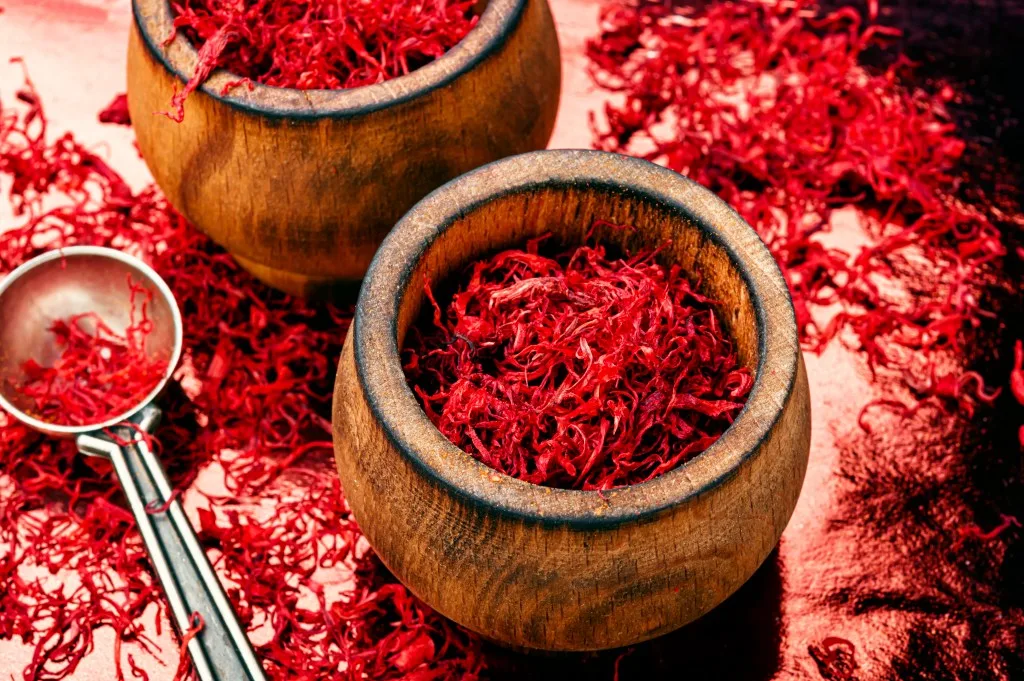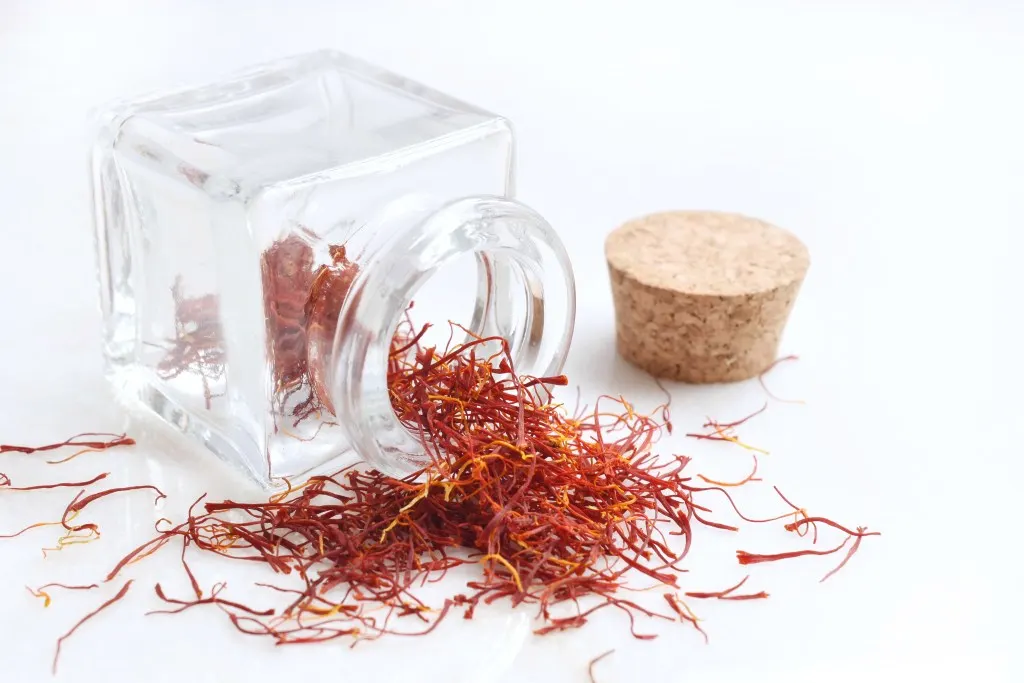Chefs know that a little saffron goes a long way. That’s a good thing, because this highly prized flavoring carries quite a price tag.
Saffron has been highly sought after for centuries and, judging from its cost, perhaps more precious than gold. Let’s find out why!
What Is Saffron?
Saffron is a pungently aromatic element to many Eastern and Middle Eastern dishes and European classics like paella and bouillabaisse.
Though it’s yellow-orange in color, saffron comes from a small purple flower with the scientific name of Crocus sativus. It’s actually a dried part of the plant’s reproductive system and is available whole, in “threads,” or powder form.
But to say that saffron is a distinctive, naturally occurring spice tells only part of its story. Besides being a food additive, saffron also has many cosmetic and medicinal uses.
For centuries, people have turned to saffron as a perfume and clothing dye. One long-standing tale has the legendary Egyptian ruler Cleopatra indulging in luxurious saffron baths more than 2,000 years ago.
Why Is Saffron So Rare?
There’s no shortage of saffron, but it’s hard to come by because harvesting it requires many hours of painstaking labor.
It comes from a part of the flower called the stigma. Each flower has three of these tiny parts, which are basically thin red threads. Workers separate them by hand from another part called the pistil.
This is tedious and delicate work, and they have to do it soon after the flowers bloom. Otherwise, the plants will wilt before the workers have had a chance to harvest this valuable commodity.
How Much Does 1g of Saffron Cost?
Like all consumer goods, saffron prices fluctuate according to supply and demand. It’s consistently considered to be one of the world’s costliest foodstuffs, however.
Depending on the quality, saffron can cost around $65 per gram, which amounts to $65,000 per kilogram.
Pro Tip: Can you use saffron while cooking? You may not want to waste the money, but you can at least try these 5 Foodie Hacks for Easy Camping Meals.

Why Is Saffron More Expensive Than Gold?
Depending on market conditions, sometimes saffron does indeed cost more than gold when comparing the two by weight.
Once again, the reason is labor. It takes a bunch of those slender red threads to add up to a substantial weight. About 450,000 of them weigh a kilogram, which is about 2.2 pounds. Because there are three to a flower, this means picking 150,000 separate flowers. That’s about 40 hours of work.
Which Country Is Rich for Saffron?
Those crocus flowers are a highly profitable cash crop for certain countries. By far, most of the saffron comes from Iran, which harvests around 300 tons of it each year. That’s about 90% of the total output around the world. Other countries that produce saffron include India, Afghanistan, Morocco, Spain, France, and Greece.
In other words, you can safely bet that the saffron you encounter in America was imported. The Pennsylvania Dutch do grow fairly small amounts for their own use but not as a commercial crop.

How Can You Tell Real Saffron?
Because it’s so expensive, other products masquerade as saffron but just don’t measure up.
For instance, a package of cheap saffron rice for under $2 at the grocery store may be artificially flavored. But even intact threads sold as authentic could be imposters, or at least not top quality.
Some say fake saffron has a more metallic scent instead of one that’s floral. It may also taste somewhat bitter, not sweet.
High-quality saffron threads turn a deeper red as they dry, but they still have yellow or orange parts. If yours are uniformly red, that could signify dying to give them a more pleasing appearance.
A surefire way to tell if it went through the dying process is to add some to boiling water. If the water turns red, it’s fake.
Is Saffron a Hallucinogenic?
We’ve touched on saffron’s supposed medicinal qualities, and they remain under debate. It’s sold widely as an herbal supplement, and some believe it’s effective against ailments ranging from depression to hypertension.
Does it have other mood-elevating qualities, as well? Some say it has psychoactive effects, while others compare its effects to opium.
What Are the Side Effects of Saffron?
There can be other effects, though. You probably wouldn’t ever ingest too much of it at a time, and that’s a good thing. Some studies say larger doses can be mildly toxic.
The possible side effects of consuming too much saffron could include nausea, dizziness, vomiting, and diarrhea.
Pro Tip: Eating a lot of spices on a travel day may not be the best thing for your stomach. Make sure to Avoid These Foods on Your Travel Day.
Where Is Saffron Used the Most?
Despite all of these other possible uses, saffron is most popular in the kitchen. A classic curry wouldn’t be complete without it, nor would a creamy risotto.
Saffron has recently gained popularity among chefs in America, but it’s long been a mainstay in other cultures.
Not surprisingly, this prized and pricy spice is most popular in places where it grows in great amounts. You will most likely encounter its tantalizing flavor in dishes in the Middle East, Asia, and Europe.
Discover the Best Free Camping Across the USA
To be honest with you, we hate paying for camping. There are so many free campsites in America (with complete privacy).
You should give it a try!
As a matter of fact, these free campsites are yours. Every time you pay federal taxes, you’re contributing to these lands.
Become a FREE CAMPING INSIDER and join the 100,000 campers that love to score the best site!
We’ll send you the 50 Best Free Campsites in the USA (one per state). Access the list by submitting your email below: